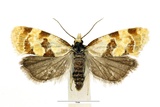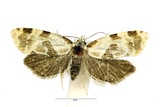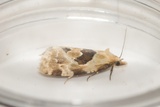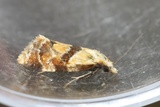Aethes rubigana (Treitschke, 1830) Species
Last modified: Nov. 22, 2025, 2:45 p.m.
A rather rare species throughout Belgium.
Details
- Classification
- Family: Tortricidae > Subfamily: Tortricinae > Tribus: Cochylini > Genus: Aethes > Species: Aethes rubigana
- Vernacular names
- Donker c-smalsnuitje (NL), Burdock Conch (EN), Klettenwickler (DE)
- Synonyms
- Aethes badiana sensu (Hübner, 1799)
- First mention in Belgium
- De Sélys-Longchamps E. 1844. Énumération des insectes Lépidoptères de la Belgique. — Mémoires de la Société royale des Sciences de Liége 2: 1–35. On page 22.
- Status
-
Native
Distribution
Imago
Wingspan 15–18mm. This species can be hardly separated from the sister species Aethes cnicana.
It can however be separated from Aethes cnicana by the combination of the widened portion on dorsum of the dorsal midspot and the distinct tornal spot. The basal spot is shorter and more rounded in A. rubigana. The dorsal midspot turns more obliquely outwards , whereas in Aethes cnicana it is almost straight.
The wing patterns of A. rubigana are brown, whereas in Aethes cnicana they are ferruginous brown. In addition, the greasy, spotted habitus is typical for A. rubigana.
Bionomics
The larva lives in stem and roots. Second generation larva bores in the flower heads after flowering has ended, feeding on the fruits. It hibernates full-fed from October in a cocoon on the ground, or, occasionally, in the seed-head. Pupation in the cocoon.
They are active in late evening and later come to light.
Flight periods
The adults usually fly from mid-May till mid-August.
Observed on
- Host plant (species):
- Arctium lappa
The larva feeds on Arctium lappa and A. minus.
Habitat
It inhabits waste ground, field edges, dumps, suburban and dry open areas.







